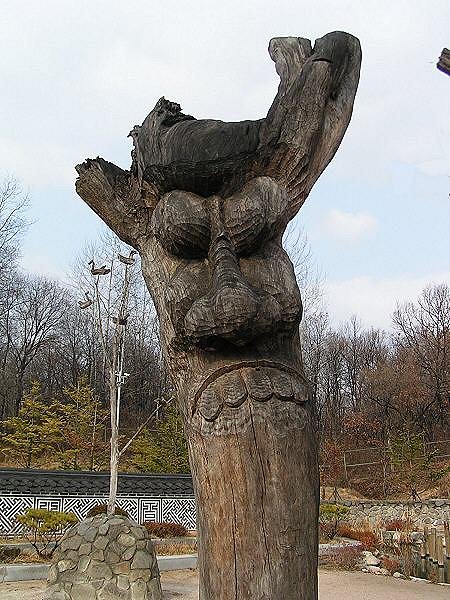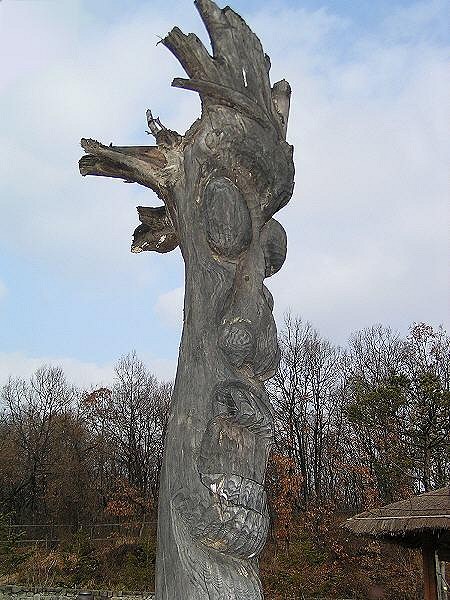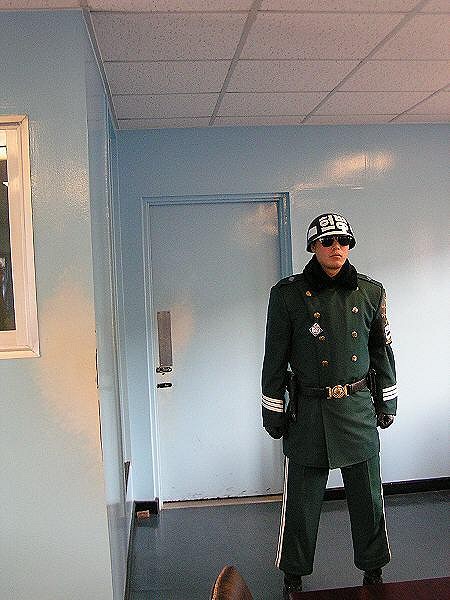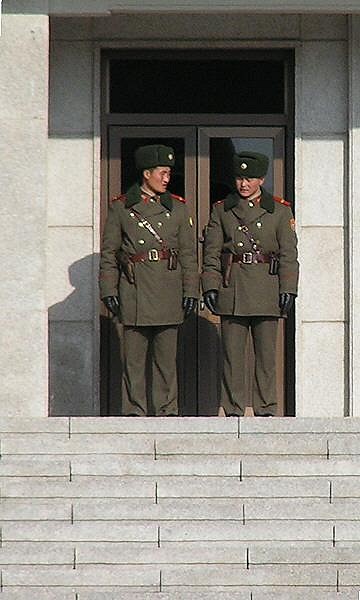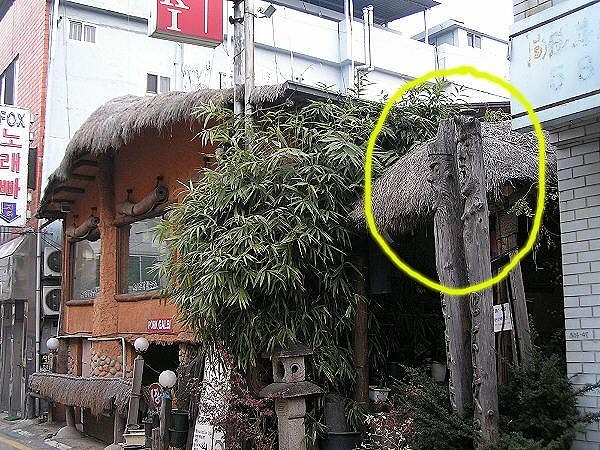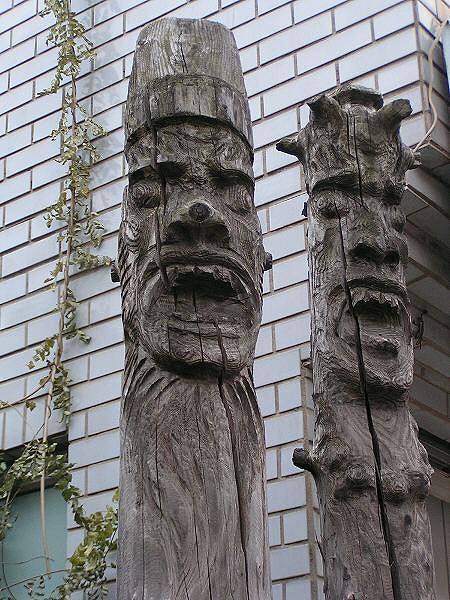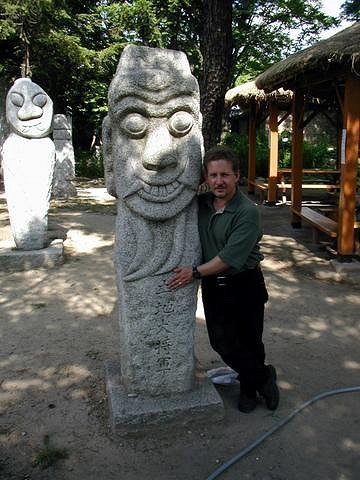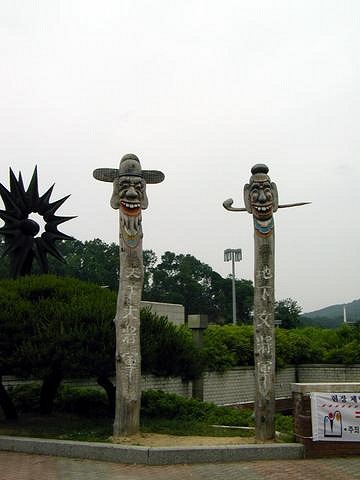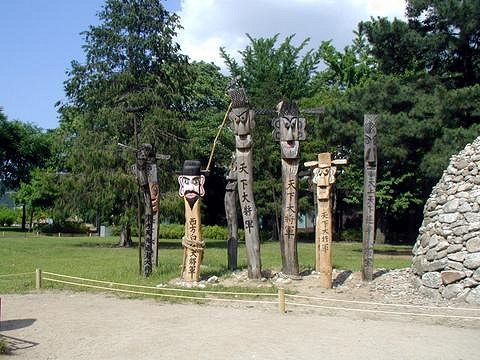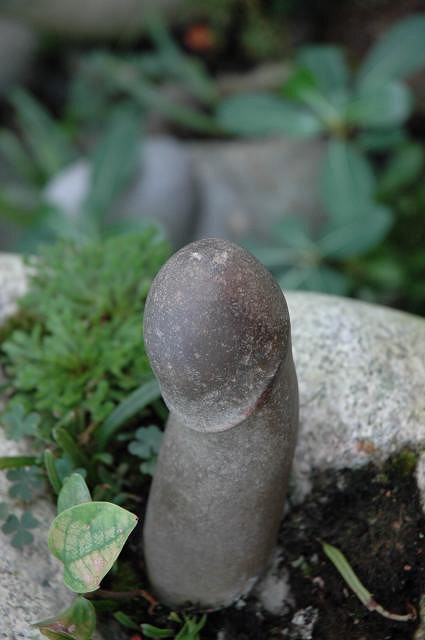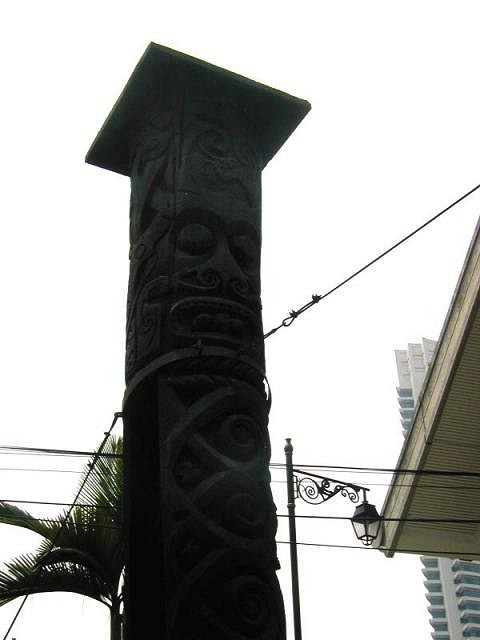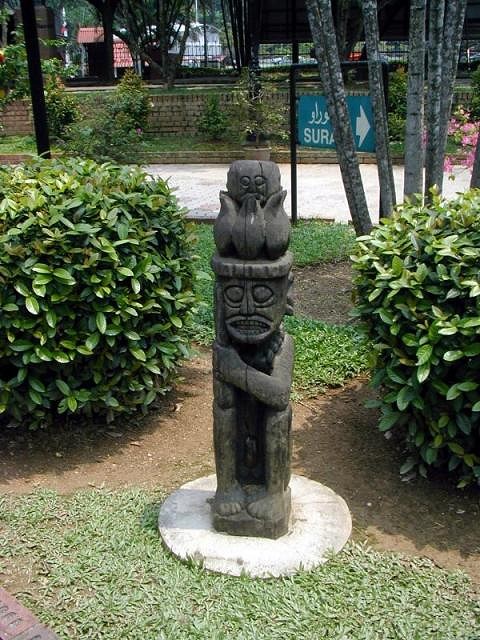Tiki Central / General Tiki
Korea DMZ tiki
Pages: 1 17 replies
|
I
ikitnrev
Posted
posted
on
Thu, Dec 21, 2006 11:26 PM
I've recently spent several weeks for work in Korea, and decided to include a small handful of pictures from that trip - some pictures with tiki, and some without. One of the highlights was taking a day tour of the Demilitarized Zone (DMZ), the heavily guarded area that separates North from South Korea. One of the stops of the DMZ tour was a location called the Third Tunnel - dug under the borderline by North Korea, apparently to help troops cross over in case they ever decided to invade, or for other unsavory purposes. This tunnel was discovered in 1978, and is one of four tunnels found in the DMZ so far. It is now a tourist site, and I was able to descend into the tunnel and walk a good portion of its length. At the surface of this Third Tunnel, is a Museum, gift shop, some interesting sculptures .... and these carvings, which immediately caught my attention. I'm not sure whether to call them tiki or not, but they seem to be influenced by and are somewhat similar of other Pacific Rim carvings. Best of all, they lie within a couple hundred meters of North Korea itself!
Later that afternoon, our tour also visited the nearby Joint Security Area (JSA), the only portion of the DMZ where North and South Koreans troops stand face-to-face. On these grounds is a small building/conference room that actually straddles the Line of Demarcation that officially separates North Korea and South Korea. I took the following picture while standing in the North Korean side of the room. The door shown leads into North Korea, and the guard shown is from South Korea. He is black-belt trained, and there to make sure that nobody makes an effort to exit or get near to that door. (Rumor has it that there are two North Korean guards posted at all times outside this door)
Outside of the above building, one can look further across the Demarcation Line, and view actual North Korean soldiers.
Well south of the DMZ area, outside Osan Air Force Base, in the city of Pyeongtaek, I discovered this thatched-roof restaurant, which had a pair of similar type carvings outside. I did not have the time to go inside this restaurant, so cannot vouch whether they served any type of rum drinks. (The only rum I saw for sale in my entire time in Korea was mainstream Bacardi)
One other place that intrigued me featured this sign outside. I walked inside, but saw only a generic bar, with one couple playing a pool table .... a typical bar geared towards young servicemen, with no real signs of tiki. But the sign is cool!
Vern [ Edited by: ikitnrev 2006-12-21 23:29 ] |
|
STCB

Sabu The Coconut Boy
Posted
posted
on
Fri, Dec 22, 2006 10:44 AM
Vern, You have found some nice Korean village guardian poles or "changseung". We've got a couple of them next to the Korean Friendship Bell at a park here in San Pedro. They are probably the closest things to Polynesian tikis that I've seen developed in a completely different culture. It's strange how this synchronicity occurs in vastly separate parts of the world. Here's a website (there are lots of them) with some nice pictures of changseung and a carver working on them: http://www.clickasia.co.kr/digicart/products/artist/art_9906.htm Sabu |
|
T
tikigap
Posted
posted
on
Fri, Dec 22, 2006 11:00 AM
Great travelogue, Vern. Thanks for posting it. |
|
V
VanTiki
Posted
posted
on
Fri, Dec 22, 2006 11:02 AM
I fell in love with these during my first visit to Korea in 1998. I snapped photos of some during my 2003 trip to Seoul - and I was dead set on buying one. After the Korean designers I was working with got over the shock that a) I knew about and loved their traditional roadside totems, and b) I wanted to actually get one to bring back to Hawaii - they promised to take me to a place in Seoul where I could get one. I was SO excited! On my last day in town, they designers led me through the city to the most horrific International Marketplace-style tourist trap that you could imagine. They had several foot high plastic versions of the carvings for sale, but I was really only after the real thing. Someone has to be carving them over there - because as you can see by my photos they are all over the city - VanTiki
|
|
HB
hala bullhiki
Posted
posted
on
Fri, Dec 22, 2006 11:16 AM
van, that second one had a few too many drinks!! |
|
F
foamy
Posted
posted
on
Fri, Dec 22, 2006 12:47 PM
Great photos Vern, Leave it to you to find the tiki's. Interesting notes, nice post. |
|
S
squid
Posted
posted
on
Fri, Dec 22, 2006 1:58 PM
WOW! Thanks for the pics guys. And thanks for the link Sabu. I really love this style! |
|
MD
Mr. Dale
Posted
posted
on
Fri, Dec 22, 2006 3:56 PM
Man....those are beautiful...can we bring those on board TC too? |
|
M
MrBaliHai
Posted
posted
on
Fri, Dec 22, 2006 5:10 PM
Vern, great pics! Hope you got to drink lots of soju, chrysthanemum wine, and pine-needle folk liquor while you were in Korea. I visited Daejon and Seoul in 2003, and was also struck by the similarity of Changseung to Polynesian tikis. Here are a couple of photos:
|
|
B
Brittanie
Posted
posted
on
Sat, Dec 23, 2006 12:45 AM
That's not all. On Cheju Island, Korea's "subtropical" vacation location to the south (they have palm trees but it's hardly subtropical) they are famous for statues called tolharubangs (a.k.a. "stone grandfathers"). Some of the island's carvings are as old as 500 years, same age as the tikis we saw in the Marquesas. Speaking of Marquesans, look at how similar these statues are — bulging eyes, hands clutching stomach, harbingers of fertility. Cheju is a former volcano, and the statues are carved out of basalt. 2007 is our last year in Korea, and Cheju is a top priority before we leave. More info at wikipedia. |
|
M
MrBaliHai
Posted
posted
on
Sat, Dec 23, 2006 5:54 AM
Given all these similarities between Korea and Polynesia, we clearly need to mount an expedition to build a raft out of empty kimchi jars and try to sail it from Pusan to Rarotonga!...:wink: |
|
I
ikitnrev
Posted
posted
on
Sat, Dec 23, 2006 10:08 AM
Thanks to Sabu, Vantiki, MrBaliHai, and Brittanie for the added insight, pictures, and links to more information on the changseungs and tolharabangs. I was completely ignorant on these things going into my trip, and it is nice to know that there are such knowledgable people on Tiki Central. I was struck by the eye pattern on Vantiki's first photo. The off-skewed angle reminded me of the same off-angle eyes on those New Zealand jade carved pendants. It really makes one wonder - was there a cross-oceanic sharing of art and culture, or did these similarities rise up independently, in a Jungian unconcious fashion, on their own? It is fascinating that so many cultures felt the need to carve representations of these figures. Vern |
|
C
Chongolio
Posted
posted
on
Sat, Dec 23, 2006 11:02 AM
Although not Tiki by the Die hard standards, this is another SITA (Shot In The Arm) post as far as I am concerned. I have long been interested and have drawn inspiration from figure, faces and other characteristics that appear in stumps, branch, twig, rock formation, wood grain etc and the artists and cultures who work with the features of an object to create a Simulacra of sorts. I have never heard of these Changseung or Tolharubang before. My interest has been piqued so I am going to learn more. Thanks for the postin' the pics and info everybody. This is the good stuff! Chongolio |
|
B
Brittanie
Posted
posted
on
Sat, Dec 23, 2006 5:13 PM
Some theorists think tikis are basically phallic symbols right? Many tiki represent fertility and almost all (even the Korea statues above) have that familiar masculine shape. These aren't tiki but they're interesting. On the Korean island where we live, an old man owns a place called something like Natural Happyland. It's basically a botanical garden full of the native plants that grow on Geoje. Also, there is a baboon in a cage. One of the man's particular interests is collecting rocks that in their undoctored state look exactly like penises. There is a huge section of this park full of lovingly displayed penis rocks, probably four or five hundred of them in all shapes and sizes planted in planters with ferns and flowers. Korean men (especially the older ones) are big on the belief that certain foods and other items are, as they say, "Good for stamina." I think these rocks are supposed to hold that same power. Anyway because deep at heart I'm really a 12-year-old boy, I took pictures. Lots. Here's just one:
|
|
H
hewey
Posted
posted
on
Sat, Dec 23, 2006 7:34 PM
Kool pics. Makes you appreciate where you live, in a big way. That lone guard looks bad-assed! Yeh, the similarity in these to tikis is surprising. Kind of in between poly tikis and American Indian totem poles... Great thread |
|
M
MrBaliHai
Posted
posted
on
Sun, Dec 24, 2006 5:21 AM
Tiki-osity appears to be a pan-Asian phenomenon. Here are a couple of tribal carvings I saw in Kuala Lumpur, Malaysia:
|
|
O
Ojaitimo
Posted
posted
on
Mon, Dec 25, 2006 8:35 AM
Great post, I lived in Okinawa in 1969 and there were carvings like the DMZ tiki carved by Ryukyan islanders whom the Japanese had invaded hundreds of years before. They continued this tradition and when weapons were banned by the Japanese they invented a form of fighting using farm tools. I am not sure, maybe one of you knows if this type of carving was initially banned. I didn't see many examples of it when I was there but maybe it was once common and there were a few I can remember. |
|
V
VampiressRN
Posted
posted
on
Mon, Dec 25, 2006 9:11 AM
"It's strange how this synchronicity occurs in vastly separate parts of the world." I agree with you Sabu....the same is the case for pyramids that occurred at the same times in sevral places on the planet. No way could all of these different societies have known what was going on in the far away places, yet the art work, buildings, and practices ran along the same lines. Great post. I do like the naturalness of including the nots and twigs in the carvings. :tiki: |
Pages: 1 17 replies


